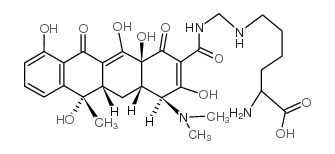992-21-2
| Name | lymecycline |
|---|---|
| Synonyms |
limecycline
[(1r,7ar)-1-hydroxy-2,3,5,7a-tetrahydro-1h-pyrrolizin-7-yl]methyl(2r,3s)-2,3-dihydroxy-2-isopropylbutanoate 2,3-Dihydroxy-2-(1-methylethyl)-butanoic acid (2,3,5,7a-tetrahydro-1-hydroxy-1H-pyrrolizin-7-yl) methyl ester lycopsamine (+)-Indicine |
| Description | Lymecycline is a tetracycline derivative, with broad-spectrum antibacterial activity and also has anti-inflammatory property. |
|---|---|
| Related Catalog | |
| Target |
Bacterial[1] |
| In Vitro | Lymecycline is a tetracycline derivative, with broad-spectrum antibacterial activity interfering with prokaryotic protein synthesis at the ribosome level. Lymecycline also has anti-inflammatory property[1]. |
| References |
| Density | 1.53 |
|---|---|
| Boiling Point | 840.5ºC at 760 mmHg |
| Melting Point | 192.5°C |
| Molecular Formula | C29H38N4O10 |
| Molecular Weight | 602.63 |
| Flash Point | 462.1ºC |
| Exact Mass | 602.25900 |
| PSA | 242.98000 |
| LogP | 1.02790 |
| Index of Refraction | 1.693 |
| Water Solubility | Very soluble in water, slightly soluble in ethanol (96 per cent), practically insoluble in methylene chloride. |
CHEMICAL IDENTIFICATION
HEALTH HAZARD DATAACUTE TOXICITY DATA
|
